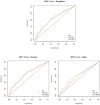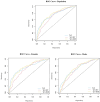The Ability of the Triglyceride-Glucose (TyG) Index and Modified TyG Indexes to Predict the Presence of Metabolic-Associated Fatty Liver Disease and Metabolic Syndrome in a Pediatric Population with Obesity
- PMID: 40217790
- PMCID: PMC11989838
- DOI: 10.3390/jcm14072341
The Ability of the Triglyceride-Glucose (TyG) Index and Modified TyG Indexes to Predict the Presence of Metabolic-Associated Fatty Liver Disease and Metabolic Syndrome in a Pediatric Population with Obesity
Abstract
Background: Metabolic-associated fatty liver disease (MASLD) and metabolic syndrome (MetS) are increasingly prevalent among children and adolescents with obesity, posing significant long-term metabolic and cardiovascular risks. Non-invasive identification of at-risk individuals is crucial for a timely intervention. This study aimed to evaluate the diagnostic performance of the triglyceride-glucose (TyG) index and its modified versions, TyG-body mass index (TyG-BMI) and TyG-waist circumference (TyG-WC), in predicting MASLD and MetS in a large cohort of children and adolescents with obesity. Methods: A total of 758 children and adolescents with obesity (454 females, 304 males; mean age 14.8 ± 2.1 years; mean BMI 37.9 ± 6.2 kg/m2) were included. MASLD was diagnosed via ultrasonography, while MetS was defined using International Diabetes Federation criteria. TyG, TyG-WC, and TyG-BMI were calculated for all participants. Receiver operating characteristic (ROC) curves were generated to assess the diagnostic accuracy of these indexes, including sensitivity, specificity, positive predictive value (PPV), and negative predictive value (NPV). Results: MASLD was detected in 38.9% of participants, with a higher prevalence in males (p < 0.0001). MetS was present in 27.8% of the cohort, with higher prevalence in males (p < 0.0001). Among the indexes, TyG-WC exhibited the highest sensitivity for MASLD (77.6%), whereas TyG-BMI had the highest specificity (63.3%). In predicting MetS, all three indexes performed better than for MASLD, with TyG demonstrating the highest PPV (54.5%) and TyG-BMI the highest NPV (87.5%). Predictive performance was lower in males than females, potentially due to sex-specific differences in fat distribution and metabolic response. Conclusions: TyG, TyG-WC, and TyG-BMI are promising, non-invasive tools for identifying children and adolescents with obesity at risk for MASLD and MetS. The superior sensitivity of TyG-WC and the high specificity of TyG-BMI highlight the value of incorporating anthropometric parameters into metabolic screening. Integrating these indexes into routine clinical practice may enhance early detection, allowing for timely intervention and personalized management strategies, ultimately reducing the long-term burden of metabolic and liver diseases in pediatric populations.
Keywords: MASLD; MetS; TyG; TyG-body mass index; TyG-waist circumference index; adolescents; children; obesity; pediatric obesity; triglyceride glucose index.
Conflict of interest statement
The authors declare that the research was conducted without any commercial or financial relationships that could be construed as potential conflicts of interest.
Figures


References
-
- Wasuwanich P., So J.M., Sadek M., Jarasvaraparn C., Rajborirug S., Quiros-Tejeira R.E., Karnsakul W. Pediatric Non-Alcoholic Fatty Liver Disease (NAFLD): Trends, Mortality, and Socioeconomic Disparities in the U.S., 1998–2020. Children. 2025;12:71. doi: 10.3390/children12010071. - DOI - PMC - PubMed
-
- Dâmaso A.R., Masquio D.C.L., Campos R.M.d.S., Corgosinho F.C., Cercato C. Effects of Multidisciplinary Therapy on Energy Balance, Inflammation, and Metabolic Diseases in Adolescents with Obesity: A Narrative Review. Ann. N. Y. Acad. Sci. 2024;1542:25–50. doi: 10.1111/nyas.15251. - DOI - PMC - PubMed
Grants and funding
LinkOut - more resources
Full Text Sources

